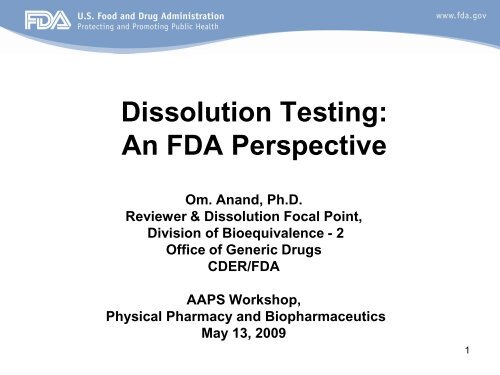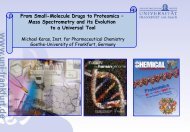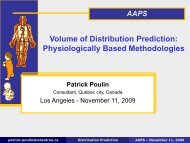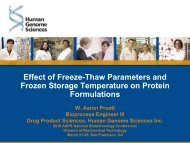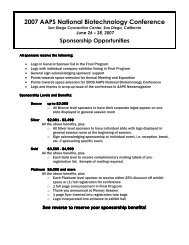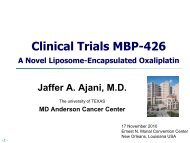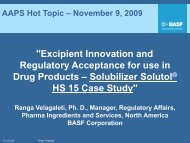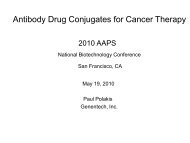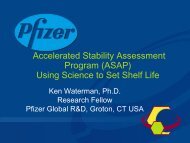Dissolution testing recommendations
Dissolution testing recommendations
Dissolution testing recommendations
You also want an ePaper? Increase the reach of your titles
YUMPU automatically turns print PDFs into web optimized ePapers that Google loves.
<strong>Dissolution</strong> Testing:An FDA PerspectiveOm. Anand, Ph.D.Reviewer & <strong>Dissolution</strong> Focal Point,Division of Bioequivalence - 2Office of Generic DrugsCDER/FDAAAPS Workshop,Physical Pharmacy and BiopharmaceuticsMay 13, 20091
The following presentation reflects theopinions of the author and does notnecessarily represent the official positionof the FDA.2
Outline, <strong>Dissolution</strong> Testing Issues• Overview of role in drug development– Immediate-release (IR) product development– Modified-release (MR) product development• FDA <strong>recommendations</strong>• Biowaivers• Post approval changes• In-vitro alcohol-induced dose-dumping• Current standing and future role3
<strong>Dissolution</strong> Testing as Tool For…• Drug development• Manufacturing process control and batchrelease• Identify potential bioavailability problems• Assess the need for furtherbioequivalence studies relative to SUPAC• Signal a formulation that may not bebioequivalent to reference product4
Role of dissolution <strong>testing</strong> in IR productsDrug Product: BA/BEPreapprovalNew Drug:BA studiesBE studies<strong>Dissolution</strong>Generic DrugClass 1: HS/HPClass 2 3 4PostapprovalBE Studies<strong>Dissolution</strong> ProfileClass 1 HS/HP/RD<strong>Dissolution</strong> for biowaiverLower strength<strong>Dissolution</strong> for biowaiverHigher strengthBE Study<strong>Dissolution</strong>Adopted from chapter 4, authored by Vinod P. Shah, from Pharmaceutical <strong>Dissolution</strong> Testing, J. Dressman (Ed) and J Kramer (Ed).5
Role of dissolution <strong>testing</strong> in MR productsDrug Product: BA/BEPreapprovalNew Drug:BA study each strengthFood effect studiesMultiple dose studies<strong>Dissolution</strong>Generic DrugLower StrengthPostapprovalBE Studies<strong>Dissolution</strong> ProfileHigher StrengthBeaded Capsules<strong>Dissolution</strong> profileTabletsProportional formulation<strong>Dissolution</strong> profile inadditional mediaBE Study at Higher strengthFood effect Study<strong>Dissolution</strong>Adopted from chapter 4, authored by Vinod P. Shah, from Pharmaceutical <strong>Dissolution</strong> Testing, J. Dressman (Ed) and J Kramer (Ed).6
NDA-<strong>Dissolution</strong> <strong>testing</strong>development report <strong>recommendations</strong>‣ pH solubility profile of the drug substance.‣ Profiles at different agitation speeds, e.g.‣ 100 to 150 rpm for USP Apparatus I (basket)‣ 50 to 100 rpm for USP Apparatus II (paddle)‣ Profiles generated on all strengths in at leastthree dissolution media‣ e.g., pH 1.2, 4.5, and 6.8 buffer‣ Water can be used as an additional medium‣ Appropriate surfactant concentrations for poorlysoluble drugs7
NDA-<strong>Dissolution</strong> <strong>testing</strong> developmentreport <strong>recommendations</strong> (cont’d)‣Sponsor selects an appropriatedissolution method with adequatediscriminating ability.‣<strong>Dissolution</strong> specifications areestablished for batch to batch qualityassurance.8
ANDA- <strong>Dissolution</strong> <strong>testing</strong> <strong>recommendations</strong>Extended release productsUSP method availableSingle strengthMultiple strengthsUSP methodadequatelydiscriminatingUSP method onlyYesCapsulesCommon blendNoTabletsAdditional dissolution<strong>testing</strong> using:Lower pH; e.g. 1.2Medium pH; e.g. 4.5Higher pH; e.g. 6.810Water
ANDA- <strong>Dissolution</strong> <strong>testing</strong> <strong>recommendations</strong>Extended release productsFDA recommended method availableUSP method not availableCapsulesTabletsCommon blendYesNoAdditional dissolution<strong>testing</strong> on highest strength only:Lower pH; e.g. 1.2Medium pH; e.g. 4.5Higher pH; e.g. 6.8Water** For biowaivers dissolution in water may not be requiredAdditional dissolution<strong>testing</strong> on all strengths:Lower pH; e.g. 1.2Medium pH; e.g. 4.5Higher pH; e.g. 6.8Water11
Plasma ConcentrationsDelayed release productsProducts that release the drugs at a time later thanimmediately after administration (i.e., these drug productsexhibit a lag time in quantifiable plasma concentrations).Typically, coatings (e.g., enteric coatings)are intended to delay the release of medication untilthe dosage form as passed through the acidic mediumof the stomach.1600800Plasma conc. Delayed release product00 4 8 12Time (hrs)12
% Dissolved<strong>Dissolution</strong> <strong>testing</strong> <strong>recommendations</strong> -Delayed release products<strong>Dissolution</strong> <strong>recommendations</strong>: stable under acidic conditions andrelease the drug only in a neutral medium.For all strengths: Stable under acidic conditions (pH 1.2) for 2 hours andrelease in neutral medium (e.g., pH 6.8).FDA does not requests dissolution profiles in multimedia for the DR products100Drug Release. Delayed release product5000 30 60 90 120 150 180Time (Minutes)13
<strong>Dissolution</strong> <strong>testing</strong> and BCS based biowaiversfor IR productsBiowaivers may be granted for BCS class 1 (high solubilityand high permeability) drug products for BE studies if thedrug product is rapidly dissolving.An IR drug product is considered rapidly dissolving whenno less than 85% of the labeled amount of the drugsubstance dissolves within 30 minutes, usingU.S. Pharmacopeia (USP) Apparatus I at 100 rpm(or Apparatus II at 50 rpm) in a volume of 900 ml orless in each of the following media: (1) 0.1 N HCl orSimulated Gastric Fluid USP without enzymes; (2) a pH4.5 buffer; and (3) a pH 6.8 buffer or Simulated IntestinalFluid USP without enzymes.14
<strong>Dissolution</strong> <strong>testing</strong> and BCS based biowaiversfor IR productsNDAs: Once the in-vivo BA of a formulation is establishedduring the IND period, waivers of subsequent in-vivo BEstudies may be possible for BCS class 1 drugs based on thedissolution <strong>testing</strong> data.ANDAs : BCS-based biowaivers can be requested forrapidly dissolving IR test products containing highlysoluble and highly permeable drug substances, providedthat the reference listed drug product is also rapidlydissolving and the test product exhibits similar dissolutionprofiles to the reference listed drug product.15
<strong>Dissolution</strong> <strong>testing</strong> and other biowaivers forIR products- PreapprovalAn in-vivo BE demonstration of one or more lower strengths can be waivedbased on dissolution tests and an in-vivo study on the highest strength if:‣ drug product is in the same dosage form, but in a different strength.‣ proportionally similar in its active and inactive ingredients to thestrength on which BA or BE <strong>testing</strong> has been conducted.<strong>Dissolution</strong> profiles in one medium are usually sufficient to support waiversof in-vivo <strong>testing</strong> if an appropriate dissolution method has been established,and the dissolution results indicate that the dissolution characteristics ofthe product are not dependent on the product strength.If an appropriate dissolution method has not been established thendissolution data in three media (pH 1.2, 4.5, and 6.8) are recommended.16
<strong>Dissolution</strong> <strong>testing</strong> and biowaivers forMR products- PreapprovalAn in-vivo BE demonstration of one or more lower strengths can be waivedbased on dissolution tests and an in-vivo study on the highest strength. Thedissolution requirements are slightly different based on type of formulation.Beaded capsulesVarious strengths differs only in thenumber of beads containing the active moietyBE studies onhighest strengthSimilar dissolution profile for each strength,using the recommended dissolution method.<strong>Dissolution</strong> based biowaiver of in-vivo studies for lower strengths17
<strong>Dissolution</strong> <strong>testing</strong> and biowaivers forMR products- Preapproval cont’dModified-Release tablets• Same dosage form, different strength• Active and inactive ingredients proportionally similar• Same drug release mechanismBE studies onhighest strengthSimilar dissolution profile between the highest strength and the lowerstrengths based on the f2 test in at least three dissolution media(e.g., pH 1.2, 4.5 and 6.8)<strong>Dissolution</strong> based biowaiver of in-vivo studies for lower strengths18
Role of dissolution <strong>testing</strong>- IR products-Postapproval changes• For any Level 1 or Level 2 change, dissolution <strong>testing</strong> may be enough(No BE study) for the post approval change to be accepted.• For Site change Level 3, dissolution <strong>testing</strong> may be enough(No BE study) for the post approval change to be accepted.• For all other Level 3 changes, dissolution <strong>testing</strong> and BE studyis necessary for the post approval change to be accepted.• However, the bioequivalence study may be waived withan acceptable in vivo/in vitro correlation which must be validated.19
Role of dissolution <strong>testing</strong>- MR products-Postapproval changesLevel 1 changeNo BE studyStandard dissolution <strong>testing</strong> may be enoughLevel 2 change*Established IVIVC availableYesNo<strong>Dissolution</strong> profile withonly standard dissolutionmethod is recommendedAdditional dissolutionprofiles besides standarddissolution methodare recommended*Except for Level 2 change related to Components and composition-Release controlling excipients20
Role of dissolution <strong>testing</strong>- MR products-Postapproval changes cont’dLevel 2 change related toComponents and composition-Release controlling excipientsNarrow therapeuticrange drugNonnarrow therapeuticrange drugNoEstablished IVIVCavailableSingle dose BE studyrecommendedYesYes<strong>Dissolution</strong> profile withonly standard dissolutionmethod is recommendedEstablished IVIVCavailableNoAdditional dissolutionprofiles besides standarddissolution method 21are recommended
Role of dissolution <strong>testing</strong>- MR products-Postapproval changesLevel 3 changeEstablished IVIVC availableYesNo<strong>Dissolution</strong> profile withonly standard dissolutionmethod is recommendedSingle dose BE study recommended22
<strong>Dissolution</strong> <strong>testing</strong> and alcohol-induced dosedumpingof generic MR oral drug products‣ Some modified-release oral dosage forms cancontain drugs and excipients which are highlysoluble in ethanol.‣ Even moderate amount of alcohol may causeproblem (dose-dumping) in vivo.‣ The Office of Generic Drugs recommends assay‣Designed to compare dissolution performance of thegeneric (test) product and the corresponding referencelisted drug‣0.1 N HCl media with differing amounts of ethanol (v/v)added to give the following percentages of ethanol in themedia:0%, 5%, 20%, and 40%23
% Dissolved<strong>Dissolution</strong> <strong>testing</strong> and alcohol-induced dosedumpingof generic MR oral drug products cont’dRepresentative dissolution profiles of test product7060504030201000 15 30 45 60 75 90 105 120Sampling Time (Minutes)0.1 N HCl 0.1 N HCl + 5% EtOH0.1 N HCl + 20% EtOH 0.1 N HCl + 40% EtOH24
% Dissolved<strong>Dissolution</strong> <strong>testing</strong> and alcohol-induced dosedumpingof generic MR oral drug products cont’dRepresentative dissolution profiles of test product4030201000 15 30 45 60 75 90 105 120<strong>Dissolution</strong> Time (Minutes)Test 0% Test 5% Test 20% Test 40%Reference 0% Reference 5% Reference 20% Reference 40%25
<strong>Dissolution</strong> <strong>testing</strong> of non-oral dosage forms• For any therapeutic activity the drug must be released fromthe dosage form• In-vitro drug release <strong>testing</strong> can be used as a quality control tool toensure consistency and reproducibility of non-oral dosage formperformance.Semisolid preparations (post-approval changes only)CreamsOintmentsGelsTransdermal patches (pre-approval)Suppositories (pre-approval)26
In-vitro dissolution <strong>testing</strong>: Current standing !!Formulation development and selectionIn vitro-in vivo correlationsQuality control toolIn-vitro surrogate for BE StudiesAscertain the need of BE studiesSafety and alcohol dose dumpingTo simulate food effect on BA/BE studies27
In vitro dissolution <strong>testing</strong>: Future role !!<strong>Dissolution</strong> <strong>testing</strong> should not only be sensitive to relevantchanges in the product formulation but also ensureconsistent performance and high quality of the product.<strong>Dissolution</strong> <strong>testing</strong> should be able to predict in-vivoperformance of drug product and thus reduce unnecessaryhuman studies, accelerate drug product development andhasten validation of post-approval changes.28
In vitro dissolution <strong>testing</strong>: Future role cont’d!!<strong>Dissolution</strong> <strong>testing</strong> developed on basis of human physiologymay allow increasingly rationalized drug developmentand regulatory tools.FDA’s effort is to reduce the regulatory burden andunnecessary human studies without sacrificing the qualityof the drug product and dissolution <strong>testing</strong> is believed toplay a major role in this effort.29
References• Guidance for industry, Bioavailability and Bioequivalence Studies for Orally Administered Drug Products -General Considerations. March 2003, CDER/FDA• Guidance for industry, <strong>Dissolution</strong> Testing of Immediate Release Solid Oral Dosage Forms. August 1997,CDER/FDA.• Guidance for industry, Waiver of in vivo Bioavailability and Bioequivalence Studies for Immediate Release SolidOral Dosage Forms Based on a Biopharmaceutics Classification System. August 2000, CDER/FDA.• Guidance for Industry: Extended Release Oral Dosage Forms: Development, Evaluation, and Application of invitro/in vivo Correlations. September 1997, CDER/FDA.• Guidance for industry, Immediate Release Solid Oral Dosage Forms: Scale-Up and Post-Approval Changes.November 1995, CDER/FDA. Guidance for industry, Modified Release Solid Oral Dosage Forms: Scale-Up andPost-Approval Changes. October 1997, CDER/FDA.• Vinod P. Shah. The role of dissolution <strong>testing</strong> in the regulation of pharmaceuticals: The FDA Perspective. In J.Dressman (Ed) and J Kramer (Ed). Pharmaceutical <strong>Dissolution</strong> Testing . Informa HealthCare, Taylor & FrancisGroup, 2005. Pp. 81-96.• Kramer et al. Historical development of dissolution <strong>testing</strong>: In J. Dressman (Ed) and J Kramer (Ed).Pharmaceutical <strong>Dissolution</strong> Testing . Informa HealthCare, Taylor & Francis Group, 2005. Pp. 1-34.• Hua Zhang, Ph.D and Lawrence X. Yu. <strong>Dissolution</strong> Testing for Solid Oral Drug Products: TheoreticalConsiderations . American Pharm. Rev. 7 95) :26-31 (2004).30
Acknowledgments• Barbara M. Davit, Ph.D., J.D.• Moheb Makary, Ph.D.• Xiaojian Jiang, Ph.D.• Paul Seo, Ph.D.• Partha Chandaroy, Ph.D.31
Thank You!32


